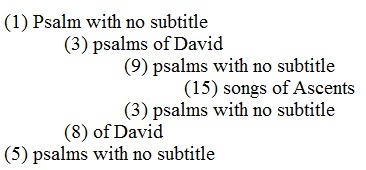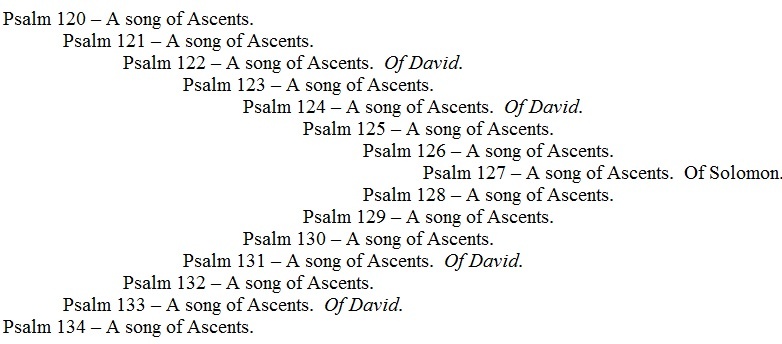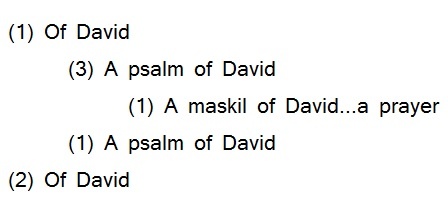The whole Psalter has been building up to Book Five. All along we have seen that there are certain psalms that are grouped together as collections and that psalms have been strategically placed where they are for particular reasons. And then we got a preview of coming attractions with some of the patterns in Book Four and how the last three Psalms of that book ended with the word Hallelujah and the last Psalm of that book also began with Hallelujah.
Books Four and Five
Psalm 106, the final psalm of Book Four, began, ”Hallelujah! Oh give thanks to YHWH, for He is good, for His loyal-love endures forever!”
Psalm 107, the first psalm of Book Five, begins, ”Oh give thanks to YHWH, for He is good, for His loyal-love endures forever!”
Psalm 118 begins and ends with the line that opens Psalm 107.
Chiasm of Book Five
But either I have missed it in earlier books, or Book Five, passes all the rest in its organizational patterns:
Psalms 111-119
The group of nine psalms with no subtitle follow an interesting pattern by their openings and closings:
Psalm 111: (”Hallelujah…”)
Psalm 112: (”Hallelujah…”)
Psalm 113: (”Hallelujah…Hallelujah”)
Psalm 114: (none)
[File away for later thought that Psalm 112 continues, ”Blessed is the man who…”).]
Psalms 111-119
Recall how Psalms 111 and 112 began with ”Hallelujah” and Psalm 113 begins and ends with it as you note the following pattern:
Psalm 115: (”…Hallelujah”)
Psalm 116: (”…Hallelujah”)
Psalm 117: (”Hallelujah…Hallelujah”)
Psalm 118: (”Oh give thanks to YHWH, for He is good, for His loyal-love endures forever!…Oh give thanks to YHWH, for He is good, for His loyal-love endures forever!”)
Psalms 111-119 and the
Alphabetic Acrostics
Now note that Psalms 111 and 112 and 119 (opening and closing this section of psalms without subtitles) are all alphabetic acrostics.
And Psalm 112 as we said to file away for later thought continued, ”Blessed is the man who…” and Psalm 119 opens, ”Blessed are those whose…”
Psalm 119 is the super-psalm alphabetic acrostic. There are eight verses per letter of the Hebrew alphabet all beginning with the same letter. Total of 176 verses.
Psalm 119
Psalm 119 is worth its own commentary.
The psalm is a wisdom psalm praising the Torah (instruction) of YHWH.
Note the diversity of terminology to refer to much the same things: law/testimony/ways/statutes/precepts/rules/word/commandments/etc.
The Fourth Alphabetic Acrostic
The fourth alphabetic acrostic in Book Five is Psalm 145. That psalm is the final psalm of the last group of psalms by David.
As I noted on an earlier occasion: there are four alphabetic acrostics in Book One of the Psalter and four alphabetic acrostics in Book Five of the Psalter.
Authorship in the Subtitles
Authorship in Book Five is ascribed only to David and David’s son Solomon.
There are a total of 14 (7×2) by David and one by Solomon. Just as the one by Solomon in Book Two was in a strategic location (ending that book), so too is the one by Solomon in Book Five.
There are four ”of David” among the Songs of Ascents and the one by Solomon. Observe where they appear next:
Chiasm of the Songs of Ascents
Chiasm of the Songs of Ascents
So not only are the collections in Book Five in a chiastic pattern but the collection at the center – the Songs of Ascents – are in a chiastic pattern.
Note that the first and last psalms in the collection are simply labeled ”a song of Ascents” as are Psalms 125-126 and Psalms 128-129. Psalm 127 is the climax: ”A song of Ascents. Of Solomon.”
And there are four ”of David” that fall in the collection at particular spots.
Chiasm of the Songs of Ascents
Psalm 121 is simply ”a song of Ascents” but the parallel Psalm 133 is ”a song of Ascents. Of David.”
Psalm 122 is ”a song of Ascents. Of David” but the parallel Psalm 132 is simply ”a song of Ascents.”
Psalm 123 is simply ”a song of Ascents” but the parallel Psalm 131 is ”a song of Ascents. Of David.”
Psalm 124 is ”a song of Ascents. Of David” but the parallel Psalm 130 is ”a song of Ascents.”
Chiasm of the Songs of Ascents
The Songs of Ascents were those psalms that the faithful one would sing when traveling up to the Temple in Jerusalem.
Jesus, the son of David, sang these as we know from the Gospels.
Hallelujahs in the Untitled Psalms
In a previous untitled psalm collection we saw the pattern of openings and closings: ”Hallelujah…,” ”Hallelujah…,” ”Hallelujah…Hallelujah,”
”…Hallelujah,” ”…Hallelujah,” ”Hallelujah…Hallelujah.”
The collection of three psalms without subtitles just after the Songs of Ascents begins with one that opens and closes this way: ”Hallelujah…Hallelujah!”
File this away for a moment.
The Davidic Collections
In the first Davidic collection in Book Five (Psalms 108-110) we find: ”a song. A psalm of David,” ”To the choirmaster. A psalm of David,” and ”A psalm of David.”
Now in the second Davidic collection in Book Five we find: ”of David,” ”to the choirmaster. A psalm of David” (2xs), ”a psalm of David,” ”a maskil of David, when he was in the cave. A prayer,” ”a psalm of David,” ”of David,” and ”a song of praise. Of David.”
The Davidic Collections
Thus both the first and the last Davidic psalms of Book Five are called ”a song.”
And the second Davidic collection forms a chiasm like that of the whole book in that there are not an equal number of psalms in each part:
The Davidic Collections
It is worth noting then that there is a mention of a prayer or prayers of David in Four out of the Five Books of the Psalter.
For Book One: Psalm 17 was ”a prayer of David.”
For Book Two the final verse reads, ”The prayers of David, the son of Jesse, are ended.”
For Book Three: Psalm 86 was ”a prayer of David.”
The only one that doesn’t fit is Book Four, which does open, ”A prayer of Moses…” (Psalm 90).
The Davidic Collections
Book Four also includes ”a prayer of one afflicted, when he is faint and pours out his complaint before YHWH.”
All this reminds us that the Psalter is also a prayer book!
The Davidic Collections
Psalm 144 is a key messianic royal hymn. It is placed where it is on purpose much like Psalm 2, and the last psalms of Book Two and Book Three.
It is followed by the last Psalm in the second Davidic collection, which is an alphabetic acrostic.
Hallelujahs in the Untitled Psalms
And this brings us to the final section of Book Five and of the Psalter: Psalms 146-150.
I said to file away the pattern of ”Hallelujah” in the untitled psalms. Remember that pattern now because all five of this collection of untitled psalms begin and end: ”Hallelujah…Hallelujah.”
The Psalter generally, but specifcally Book Five especially, has been building up to this Hallelujah finale. And Psalm 150 clearly is finale material.
The whole Psalter has been building up to Book Five. All along we have seen that there are certain psalms that are grouped together as collections and that psalms have been strategically placed where they are for particular reasons. And then we got a preview of coming attractions with some of the patterns in Book Four and how the last three Psalms of that book ended with the word Hallelujah and the last Psalm of that book also began with Hallelujah (making the pattern of: “…Hallelujah,” “…Hallelujah,” “Hallelujah…Hallelujah”).
Psalm 106, the final psalm of Book Four, began, ”Hallelujah! Oh give thanks to YHWH, for He is good, for His loyal-love endures forever!” Psalm 107, the first psalm of Book Five, begins, ”Oh give thanks to YHWH, for He is good, for His loyal-love endures forever!” Psalm 118 begins and ends with the line that opens Psalm 107. Thus books Four and Five are more closely tied to each other than they are to the previous books.
Chiasm of Book Five
But either I have missed it in earlier books, or Book Five, passes all the rest in its organizational patterns:

Psalms 111-119
The group of nine psalms with no subtitle follow an interesting pattern by their openings and closings:
Psalm 111: (”Hallelujah…”)
Psalm 112: (”Hallelujah…”) [File away for later thought that Psalm 112 continues, ”Blessed is the man who…”).]
Psalm 113: (”Hallelujah…Hallelujah”)
Psalm 114: (none)
Recall above how Psalms 111 and 112 began with ”Hallelujah” and Psalm 113 begins and ends with it as you note the following pattern:
Psalm 115: (”…Hallelujah”)
Psalm 116: (”…Hallelujah”)
Psalm 117: (”Hallelujah…Hallelujah”)
Psalm 118: (”Oh give thanks to YHWH, for He is good, for His loyal-love endures forever!…Oh give thanks to YHWH, for He is good, for His loyal-love endures forever!”)
Psalms 111-119 and the Alphabetic Acrostics
Now note that Psalms 111 and 112 and 119 (opening and closing this section of psalms without subtitles) are all alphabetic acrostics. And Psalm 112 as we said to file away for later thought continued, ”Blessed is the man who…” and Psalm 119 opens, ”Blessed are those whose…” Psalm 119 is the super-psalm alphabetic acrostic. There are eight verses per letter of the Hebrew alphabet all beginning with the same letter. Total of 176 verses.
Psalm 119
Psalm 119 is worth its own commentary.The psalm is a wisdom psalm praising the Torah (instruction) of YHWH. Note the diversity of terminology to refer to much the same things: law/testimony/ways/statutes/precepts/rules/word/commandments/etc.
The Fourth Alphabetic Acrostic
The fourth alphabetic acrostic in Book Five is Psalm 145. That psalm is the final psalm of the last group of psalms by David. As I noted on an earlier occasion: there are four alphabetic acrostics in Book One of the Psalter and four alphabetic acrostics in Book Five of the Psalter.
Authorship in the Subtitles
Authorship in Book Five is ascribed only to David and David’s son Solomon. There are a total of 14 (7×2) by David and one by Solomon. Just as the one by Solomon in Book Two was in a strategic location (ending that book), so too is the one by Solomon in Book Five. There are four ”of David” among the Songs of Ascents and the one by Solomon. Observe where they appear next:
Chiasm of the Songs of Ascents

So not only are the collections in Book Five in a chiastic pattern but the collection at the center – the Songs of Ascents – is in a chiastic pattern.
Note that the first and last psalms in the collection are simply labeled ”a song of Ascents” as are Psalms 125-126 and Psalms 128-129. Psalm 127 is the climax: ”A song of Ascents. Of Solomon.” And there are four ”of David” that fall in the collection at particular spots.
Psalm 121 is simply ”a song of Ascents” but the parallel Psalm 133 is ”a song of Ascents. Of David.”
Psalm 122 is ”a song of Ascents. Of David” but the parallel Psalm 132 is simply ”a song of Ascents.”
Psalm 123 is simply ”a song of Ascents” but the parallel Psalm 131 is ”a song of Ascents. Of David.”
Psalm 124 is ”a song of Ascents. Of David” but the parallel Psalm 130 is ”a song of Ascents.”
The Songs of Ascents were those psalms that the faithful one would sing when traveling up to the Temple in Jerusalem. Jesus, the son of David, sang these as we know from the Gospels.
Hallelujahs in the Untitled Psalms
In a previous untitled psalm collection we saw the pattern of openings and closings: ”Hallelujah…,” ”Hallelujah…,” ”Hallelujah…Hallelujah,” ”…Hallelujah,” ”…Hallelujah,” ”Hallelujah…Hallelujah.” The collection of three psalms without subtitles just after the Songs of Ascents begins with one that opens and closes this way: ”Hallelujah…Hallelujah!” File this away for a moment.
The Davidic Collections
In the first Davidic collection in Book Five (Psalms 108-110) we find: ”a song. A psalm of David,” ”To the choirmaster. A psalm of David,” and ”A psalm of David.”
Now in the second Davidic collection in Book Five we find: ”of David,” ”to the choirmaster. A psalm of David” (2xs), ”a psalm of David,” ”a maskil of David, when he was in the cave. A prayer,” ”a psalm of David,” ”of David,” and ”a song of praise. Of David.”
Thus both the first and the last Davidic psalms of Book Five are called ”a song.” And the second Davidic collection forms a chiasm like that of the whole book in that there are not an equal number of psalms in each part:

It is worth noting then that there is a mention of a prayer or prayers of David in four out of the five Books of the Psalter. For Book One: Psalm 17 was ”a prayer of David.” For Book Two the final verse reads, ”The prayers of David, the son of Jesse, are ended.” For Book Three: Psalm 86 was ”a prayer of David.” The only one that doesn’t fit is Book Four, which does open, ”A prayer of Moses…” (Psalm 90). Book Four also includes ”a prayer of one afflicted, when he is faint and pours out his complaint before YHWH.” All this reminds us that the Psalter is also a prayer book!
Psalm 144 is a key messianic royal hymn. It is placed where it is on purpose much like Psalm 2, and the last psalms of Book Two and Book Three. It is followed by the last Psalm in the second Davidic collection, which is the alphabetic acrostic we noted already.
Hallelujahs in the Untitled Psalms (continued)
And this brings us to the final section of Book Five and of the Psalter: Psalms 146-150. I said to file away the pattern of ”Hallelujah” in the untitled psalms. Remember that pattern now because all five of this collection of untitled psalms begin and end: ”Hallelujah…Hallelujah.”
The Psalter generally, but specifcally Book Five especially, has been building up to this Hallelujah finale. And Psalm 150 clearly is finale material.



Recent Comments